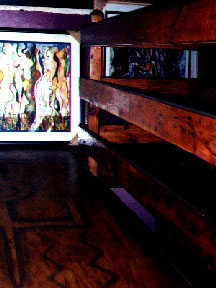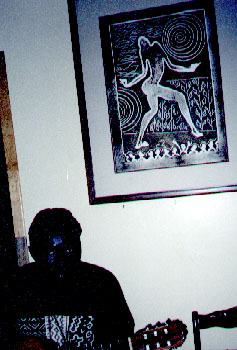Judging from the large amount of work that is immaculately displayed inYou know that's where I spend most of my time, there at
Senegal. I left when I was 18 and now I'm 42, I've been
Everywhere in the world so far. But this is the longest
I've ever stayed somewhere else.
-Aziz, Artist and owner of Aziz Gallery
 cultural
festivals such as New Orleans' Mardi Gras. Often times, with every month
of the year Aziz finds himself in a different location, both in the United
States and abroad. And, has probably seen more of the United States than
many American born citizens, as he continuously drives across country for
his staple income. A feat he has been doing repeatedly for about a decade
now.xxxv Time is spent between his adopted American continent and that
of his west African homeland. His presence
cultural
festivals such as New Orleans' Mardi Gras. Often times, with every month
of the year Aziz finds himself in a different location, both in the United
States and abroad. And, has probably seen more of the United States than
many American born citizens, as he continuously drives across country for
his staple income. A feat he has been doing repeatedly for about a decade
now.xxxv Time is spent between his adopted American continent and that
of his west African homeland. His presence
The gallery space in and of
itself highlights the use of art. Glazed,
burned in etchings adorn
the wood paneling of the stairs leading to
gallery and the U-shaped
gallery floor. The white plastered walls have
embedded in them tiny images
and shells which add greater depth to the
non-uniformed walls whose
built-in cracks serve both as home to these
permanent gifts and as backdrop
to bright and bold colored original art
by Aziz. The art ranges in
sizes and patterns, however, a common thread
is that familiar scenes involving
Africans or African-Americans are
evidently favored.
In describing his artistic muses, Aziz states his paintings are inspired my distinct and familiar moments. "It's just when and what I feel in a particular moment. I just want to paint the moment and after I finish the work, I'm released." There are times when a moment of interest appears, but he most hold onto it to paint later. He points to an example. The painting is of a woman caught in an instance of surprise when her companion, "a man who never really gives flowers, and he comes with a flower."xxxvi The woman portrayed sees this and is shocked. Her expression is vibrantly expressed on canvas with a open, smiling mouth, a hand n the table and chest sucked upward awhile gazing at the flower in front of her. While the images themselves are eye catching, what is even more striking is the fact that Aziz has achieved prominence in the arts without any formal training, which he felt "would had been fun."xxxvii
When asked what abut Leimert
Park has held his attention for the past
five years of being a common
sight Aziz suggests it is his own decision
to be apart of the community.
In his response also is evidence of how
informal networking and word
of mouth increases the positive exposure of
the Village.
In comparison to Senegal, the Southern California climate and landscapeIf it was about money, than this is the wrong place for me
to go and come and show work. But I'm trying, instead of
being in Beverly Hills or something like that. I think that if I
am here long enough, I do business with everybody else. There
is no discrimination. But I can bring people here. By me
bringing them here, they don't have to come and buy my work,
but they can come here and accidentally see something they
wouldn't have necessarily seen if I didn't have the contacts
to bring them here.
A place where on a recent Friday night, people strolled the streets atAziz suggests other similarities between Leimert Park and Senegal. Both
midnight without fear. They browsed through cluttered art galleries,
shopped for handmade earrings and drank espresso at sidewalk tables
while listening to smoky sounds of jazz.It's the kind of place Los Angeles often dreams of being. But dream no
more.With so much of Los Angeles so often dismissed as a wasteland of crack
and gangs, the Southwest L.A. neighborhood call Leimert Park is a
little known diamond in the rough that rises above the urban madness.
It is a haven for artists, poets, and musicians and a tribute to the success
of a string of businesses owned and operated by African-Americans.xxxix

Aziz's self-described involvement
in Leimert Park is viewed as being both "temporary and permanent" because
of constant traveling. Locals offer a different view. Through out the interview
there were interruptions of the curious who walked upstairs to the gallery
to view his work while the hum of his pager continuously signaled calls
as far away as Europe and Africa. What prompted the best illustration of
this artist's communal concern were also obviously both slightly curious
and irritated at my presence, they probably could not afford a print copy
of his work. Yet, these three young school children, a girl and two boys,
who requested Aziz's attention as if they were asking for that of an older,
doting sibling; and promptly received it.